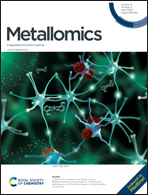Distribution and chemical form of selenium in Neptunia amplexicaulis from Central Queensland, Australia†
Abstract
Selenium (Se), a trace element essential for human and animal biological processes, is deficient in many agricultural soils. Some extremely rare plants can naturally accumulate extraordinarily high concentrations of Se. The native legume Neptunia amplexicaulis, endemic to a small area near Richmond and Hughenden in Central Queensland, Australia, is one of the strongest Se hyperaccumulators known on Earth, with foliar concentrations in excess of 4000 μg Se g−1 previously recorded. Here, we report on the Se distribution at a whole plant level using laboratory micro X-ray Fluorescence Microscopy (μXRF) and scanning electron microscopy (SEM-EDS), as well as on chemical forms of Se in various tissues using liquid chromatography-mass spectrometry (LC-MS) and synchrotron X-ray absorption spectroscopy (XAS). The results show that Se occurs in the forms of methyl-selenocysteine and seleno-methionine in the foliar tissues, with up to 13 600 μg Se g−1 total in young leaves. Selenium was found to accumulate primarily in the young leaves, flowers, pods and taproot, with lower concentrations present in the fine-roots and stem and the lowest present in the oldest leaves. Trichomes were not found to accumulate Se. We postulate that Se is (re)distributed in this plant via the phloem from older leaves to newer leaves, using the taproot as the main storage organ. High concentrations of Se in the nodes (pulvini) indicate this structure may play an important a role in Se (re)distribution. The overall pattern of Se distribution was similar in a non-Se tolerant closely related species (Neptunia gracilis), although the prevailing Se concentrations were substantially lower than in N. amplexicaulis.

- This article is part of the themed collection: Phytometallomics


 Please wait while we load your content...
Please wait while we load your content...